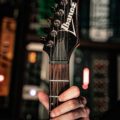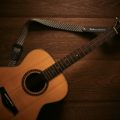 If you want to learn guitar at an advanced level, it’s crucial to memorize the fretboard. This essential task greatly aids in mastering Music Production - Improve Your Sound - The rise in popularity of work-from-home studios has significantly impacted the music production landscape in recent years, driven by the increasing availability of tools and technology. This growth has led to the emergence of mobile recording rigs, making it possible to record full band performances anywhere. While one might anticipate a wealth of high-quality music,… chords and scales. For example, consider a simple chord: C major. It consists of three notes: C (root), E (major 3rd), and G (5th). If you know the fretboard, you can play it anywhere because you know where each note is located.
If you want to learn guitar at an advanced level, it’s crucial to memorize the fretboard. This essential task greatly aids in mastering Music Production - Improve Your Sound - The rise in popularity of work-from-home studios has significantly impacted the music production landscape in recent years, driven by the increasing availability of tools and technology. This growth has led to the emergence of mobile recording rigs, making it possible to record full band performances anywhere. While one might anticipate a wealth of high-quality music,… chords and scales. For example, consider a simple chord: C major. It consists of three notes: C (root), E (major 3rd), and G (5th). If you know the fretboard, you can play it anywhere because you know where each note is located.
In the first position, it’s straightforward: place your first finger on the first fret (second string), second finger on the second fret (fourth string), and third finger on the third fret (fifth string). What if you want to play a C minor chord? Simply replace E major with E minor. In other words, replace E with Eb. But where is Eb? Knowing the fretboard helps you locate it. Once you’re familiar with the fretboard, you know that the first string is called E and the sixth string is called E. In the first position C major chord, you don’t press either the first or the sixth string. However, you can find Eb on the fourth string: D. Just press it on the first fret to get D#, which is the same as Eb. So, you realize you need to press two strings on the same fret, which requires a barre chord.
When discussing scales, the importance of knowing the fretboard becomes even more apparent: you must deal with notes. Scales are essentially collections of notes. Let’s consider the pentatonic minor scale, for example. The notes are: 1, b3, 4, 5, b7 – five notes in total (PENTA-tonic). The C pentatonic minor scale consists of these notes: C, Eb, F, G, and Bb. If you know the fretboard, you can quickly determine where to place your fingers.
You understand that memorizing the fretboard is fundamental, but how do you learn it? A powerful exercise involves using a metronome. Set it at a slow speed and play the first string on the first fret, then identify the note you get (it’s F). Next, play the first string on the second fret and identify the note (it’s F#). Continue this process along the fretboard. Play the strings on each beat and identify the notes every time. Once you’re comfortable with the current speed, increase it and start over. This enjoyable exercise will help you learn the entire fretboard quickly.
Now that you know the whole fretboard, you can start learning guitar Learn Novice Guitar - There are only a few ways to learn how to play the novice guitar. Fortunately, there is a new and improved method that allows beginners to learn faster and have more fun in the process. This method involves using specially designed software. Novice Guitar Learning novice guitar involves more than just notes and chords. The… solos. It’s best to learn them by ear, which can be fun and easy. If you struggle with fast licks, consider using a tool that slows down music. You can slow guitar solos to a manageable pace and gradually increase the speed as you become more comfortable.
Manuel Marino is a seasoned Senior Producer, Music Composer, and Artist with over a decade of experience. He specializes in branded entertainment across various mediums, including video games, films, and advertising campaigns. With 20+ years as a game music composer, Manuel has worked on numerous platforms, creating diverse orchestral soundtracks. HIRE ME


 Manuel is a passionate, driven, and techsavvy AV technician,
Manuel is a passionate, driven, and techsavvy AV technician, 










